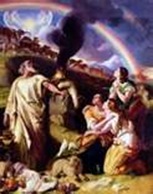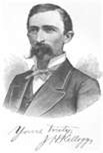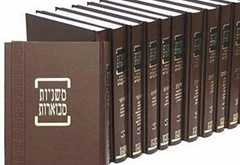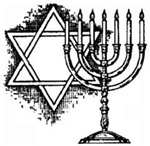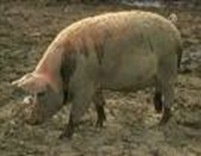This post continues with my notes on the collection of essay by James B. Jordan entitled “Studies in Food and Faith” available from Biblical Horizons.
At this point in Jordan’s essays, he has written a section on animals and their relation to men in the Bible as a background to understanding the dietary laws. The main point being made thus far is that the categories of clean and unclean animals in Leviticus 11 have only a religious, Biblical symbolic meaning. In order to show this, we first have to become familiar with Biblical symbolism.
What is Biblical Symbolism?
Biblical symbolism comes from the doctrine of creation.
 The worldview of many people today is one of a vast silent universe in which earth is just a tiny insignificant speck. Human beings are an even tinier speck on this tiny speck called earth. The world around us and all it contains is to them an accident. The only meaning the world around them can have is the meaning people give to it. Any symbols are man-made with man-made meanings.
The worldview of many people today is one of a vast silent universe in which earth is just a tiny insignificant speck. Human beings are an even tinier speck on this tiny speck called earth. The world around us and all it contains is to them an accident. The only meaning the world around them can have is the meaning people give to it. Any symbols are man-made with man-made meanings.
The view of the world that the Bible gives us however is much different. It is a created world that shows the imprint of its Maker and joyfully proclaims who He is.
It is a world full of revealed meaning. A world full of the revelation of God. The Bible teaches that what can be known about God is plain to everyone in the things that have been made. So plain in fact, that everyone who denies knowing about God is without excuse and are suppressing that truth in their minds through their own unrighteousness.
For the wrath of God is revealed from heaven against all ungodliness and unrighteousness of men, who by their unrighteousness suppress the truth.
For what can be known about God is plain to them, because God has shown it to them.
For his invisible attributes, namely, his eternal power and divine nature, have been clearly perceived, ever since the creation of the world, in the things that have been made. So they are without excuse. Romans 1: 18-20;
This passage teaches us that every created thing teaches us something about God. Every created thing symbolizes Him and reflects His character in some way. Everything points to God. Everything is a sign or symbol of God.
This means that the Christian view of the world is fundamentally symbolic. The world does not exist for its own sake, but as a revelation of God.
How a created symbol symbolizes God is not willy-nilly guesswork on our part. The Bible teaches us how to read these symbols. The Bible teaches us how to read the world, to see the world through God’s eyes. The symbolism in the Bible is not arbitrary but based in creation design.
 The first chapter of the Bible introduces us for the first time to these visual images that are packed with symbolic meaning. It sets up a grid or matrix through which we see the world biblically. For instance, our modern minds see the lizard, the cockroach, and the mouse as three different kinds of animals and rightly so. But the Bible places them all in the category of “creeping things.” This is the Biblical category and it is used throughout Scripture this way. Knowing this helps us understand and interpret a passage that speaks of “creeping things.” For instance, all creeping things are declared unclean. Why? It is because they crawl in the dirt, the dust of the ground that is cursed for our sakes and they are boundary transgressors. More on this later…
The first chapter of the Bible introduces us for the first time to these visual images that are packed with symbolic meaning. It sets up a grid or matrix through which we see the world biblically. For instance, our modern minds see the lizard, the cockroach, and the mouse as three different kinds of animals and rightly so. But the Bible places them all in the category of “creeping things.” This is the Biblical category and it is used throughout Scripture this way. Knowing this helps us understand and interpret a passage that speaks of “creeping things.” For instance, all creeping things are declared unclean. Why? It is because they crawl in the dirt, the dust of the ground that is cursed for our sakes and they are boundary transgressors. More on this later…
There are many more images in Genesis 1: lights in the sky, sea, dry land, the firmament, plants, day, night, etc. As we continue to read past Genesis 1, the symbolic meaning of these images is unpacked for us in the rest of Scripture so that by the time we get to the book of Revelation almost all of these images seem to come rushing at us at once. God communicates to us through these symbols. If we understand them, we can better understand the Bible.
We can better understand Who God is. We can better understand who we are.
For example, the Bible says that God is like a rock, a tree, a wind, and the sun, just to name four.
The doctrine of creation also teaches us that the primary symbol of God is man. Man is the image of God, the special symbol of God.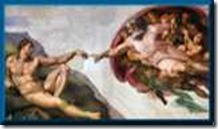
In this way the Bible tells us that whatever symbolizes God also symbolizes man.
We are to be like a rock, a tree, a wind, and the sun.
In the ancient biblical times, men understood and thought this way this better than we do today. This is because we live under the influence of a culture with a Greek view of the world and many of us have acquired a suspicion of symbolism and symbolic interpretation.
I remember growing up and being leery of symbolism and imagery. I felt that you could go overboard with it and saw many strange symbolic interpretations (there are bad jobs of it out there). I only wanted a systematic interpretation in logical language, that’s what made sense to me and I demanded it in my own thinking.
The study of symbolism is seen by some as a curiosity, rather far removed from the central matters of life. According to them, anyone who spends time studying Biblical imagery and symbolism may well be getting into a "dangerous" area. Persons who engage in an "overly symbolic" interpretation of Scripture are to be regarded with suspicion. What matters is the study of reality; symbolism is secondary.
This attitude betrays the influence of the Greek view of the world. According to the Greeks – and actually all pagans – the world was not made by God. Rather, the world, or the raw material of the world, has always existed. This always-existing stuff just is, and so it is called "Being." This "Being" stuff is like a blank slate. It is silent and meaningless "raw material." It does not bear the impress of any Creator, and it does not joyfully shout His name (Psalm 98:4-9).
Through New Eyes, by James B. Jordan, pg 27
My leeriness for symbolism and demand for truth in plain, abstract or philosophical language is not a Biblical one. It caused me to read in only certain familiar sections of the Bible that were more comfortable to me. I read more teaching passages like Paul’s epistles. I avoided Ezekiel and Isaiah and Zechariah, because I (I realize now) did not have the biblical-symbolic mindset to understand them.
But God reveals truth to us in most of the Bible through symbolism and imagery, parables, typological pictures, stories and poems. Our modern Greek-like tendency is to try to boil this way of revealing truth down to abstract logical language. In fact, we Christians have done this for centuries. Open up our catechisms like the wonderful Westminster Confession of Faith and what does it say? What is justification? What is sanctification? What is original sin? etc. These systematic ways of teaching the Bible are almost completely empty of biblical imagery.
In contrast to this, open up the book of Proverbs, which like the catechisms is supposed to be for instructing young men and women, and you encounter all kinds of biblical imagery used to communicate wisdom.
I came to believe that, in order to understand the Bible, I needed to immerse my mind into the symbols and imagery of the Bible and understand them the way the Bible uses them. The difference for me has been astounding and wonderful. Some passages that were really difficult now make profound sense to me. Entire books of the Bible that I never read and found strange and uninteresting, I’m now excited about and reading and learning from them. Books like Leviticus, Ezekiel, Zechariah, Lamentations, and Revelation.
Why Symbolism?
I believe, God uses symbols and imagery to speak to us because it is the most powerful way to do so. A symbol communicates eternal truths on many levels at the same time. In Scripture, the Holy Spirit uses biblical symbolism and imagery to say many things to us at once and shape our way of thinking and living.
Biblical symbolism communicates eternal truth without shaving away the sublime, the mysterious, the awe, or the glory of that truth the way cold abstract philosophical language does.
Be Like a Tree
I want to take one symbol from the above list and show how I use biblical symbolism to read and understand a passage. When the Bible tells us in Psalm 1 that we should be like a tree, I try to call to my mind all the trees and tree-like things in the Bible and what they say to me about trees and their meaning:
Two trees in the garden, olive branch of Noah, altars were built under trees by Abraham, the judges judged underneath trees, Abraham ate with God under a tree, Psalm 1 tree planted by waters bearing fruit, the staff of Aaron that budded, Solomon’s House of the Cedars of Lebanon, Nebuchadnezzar’s Tree Dream, ark made of wood, wooden things in the tabernacle and Temple covered with gold, the golden lamp stand which is a stylized almond tree, cursed is everyone hung on a tree, the tree-houses of the Feast of Tabernacles, high places of false worship under trees, olive oil trees of Zechariah’s night visions, Zacheus in a tree trying to see Jesus, Jesus curses an unfruitful tree, Jesus is hung on a tree, the Trees of Life and Healing in the New Jerusalem.
This is not a complete list of course. But I can use these to help me answer the question “How should I be like a tree?”
I should be a firmly grounded person in my knowledge of Scripture, I grow as I work on this. I should be a shelter and protection for those under my care. I should be a provider of food and healing. I should be a provider of comfort (like shade). I should be a ladder to heaven (others should be able to see my life and understand the gospel and become saved) like the Tree of Life, climb my branches to get to heaven, so to speak. I should be a source of wisdom to those around me like the Tree of Knowledge. I should live in such a way that my life is crowned with a canopy of glory. I should be clothed in glory. I should be light and warmth, like the lamp stand or the burning bush. I should be filled with the Spirit, like the olive oil of the olive tree. My hope is to be useful wood for the Kingdom, that some day I will be glorified, like gold covered wood. I need to be a wise judge/elder when people come to me for counsel. Sometimes in my life, I will experience death and resurrection, like a deciduous tree. But I must remember that I have eternal life, whose leaf will not wither, like an evergreen tree. And on and on…
All of this, and much more, is said to us when the Bible says God is like a tree and you should be like a tree. Hopefully, this is a helpful although short example.
Food and Faith
Food and eating in the bible are very important and are no less symbolic than any other aspect of the created order. Food and eating have meaning in the Bible. They have meaning for us today, particularly in Communion.
 When God set up the restricted diet from the Mosaic Covenant to the New Covenant, it was for symbolic purposes that changed and shaped his covenanted people and prepared them to be priests to the Nations and to bring Christ into the world.
When God set up the restricted diet from the Mosaic Covenant to the New Covenant, it was for symbolic purposes that changed and shaped his covenanted people and prepared them to be priests to the Nations and to bring Christ into the world.
This is what I will explore in the coming posts.
NOTES:
For more reading on biblical symbolism, I can recommend the following books: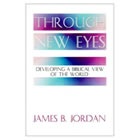
Through New Eyes by James B. Jordan, this book serves as a primer on understanding Biblical symbolism and it’s free! You can find his lecture series for pennies at www.wordmp3.com.
 The Shadow of Christ in the Law of Moses by Vern Poythress. Excellent book, not free.
The Shadow of Christ in the Law of Moses by Vern Poythress. Excellent book, not free.
 Paradise Restored by David Chilton, also an excellent introduction to Biblical symbolism and how it helps us understand Bible prophecy. Also free! I quoted from this book in a previous post on biblical symbolism.
Paradise Restored by David Chilton, also an excellent introduction to Biblical symbolism and how it helps us understand Bible prophecy. Also free! I quoted from this book in a previous post on biblical symbolism.
Read Full Post »
 This post continues with my notes on the collection of essays by James B. Jordan entitled “Studies in Food and Faith” available from Biblical Horizons.
This post continues with my notes on the collection of essays by James B. Jordan entitled “Studies in Food and Faith” available from Biblical Horizons.
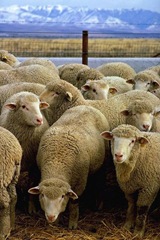
 The sea is used to represent the Gentile nations while the land is used to represent Israel. When God sends a Gentile nation to invade the Israel, He describes the enemy coming in as flood on the land (Jer. 46:6-8). Jonah falling into the sea and into the great fish was a picture of the northern kingdom being taken into Assyria, which happened soon afterwards. The Gentile empires that rise up in Daniel 7 first come as beasts from the sea. In the book of Revelation 20, Gog and Magog gather for battle and their number is like the sand of the sea. In Revelation 21:1, in the new heavens and new earth, there is no more sea, meaning no more Gentile unbelievers.
The sea is used to represent the Gentile nations while the land is used to represent Israel. When God sends a Gentile nation to invade the Israel, He describes the enemy coming in as flood on the land (Jer. 46:6-8). Jonah falling into the sea and into the great fish was a picture of the northern kingdom being taken into Assyria, which happened soon afterwards. The Gentile empires that rise up in Daniel 7 first come as beasts from the sea. In the book of Revelation 20, Gog and Magog gather for battle and their number is like the sand of the sea. In Revelation 21:1, in the new heavens and new earth, there is no more sea, meaning no more Gentile unbelievers.






 Paradise Restored
Paradise Restored

